Byron at War
BYRON BAY LOCALS WHO SERVED IN WORLD WAR I.
The young men of the Byron Bay area answered the call to fight in World War 1 with the same commitment as those from around the rest Australia. Most that served were labourers, farm hands, and other manual workers. Some joined within a few days of war being declared and others toward the end of the conflict. Many of these soldiers saw several years of service; being injured, treated and returned to the battle-lines sometimes more than once. Others saw but a few months. Some survived the battlefields to see the armistice signed on 11 November 1918 but weakened by war they succumbed to the late 1918 influenza epidemic before they could return to Australia. Others made it home thinking they had a new life to live and enjoy but died in the influenza pandemic that reached Australia in early 1919. A number of those that did return were injured and traumatised so badly that it was impossible for them to return to their previous lives or lead other normal lives.
But not all of them returned home. There are the names of 19 local men who made the ultimate sacrifice in WWI listed on the remembrance gates at the Byron Bay Memorial Park. Most died on the major battlefields of that war stretching from Gallipoli to Palestine to the Western Front. Some died of wounds received in action or from illness contracted or from the after effects of gassing. Some died before their 20th birthday. All died in the prime years of life.
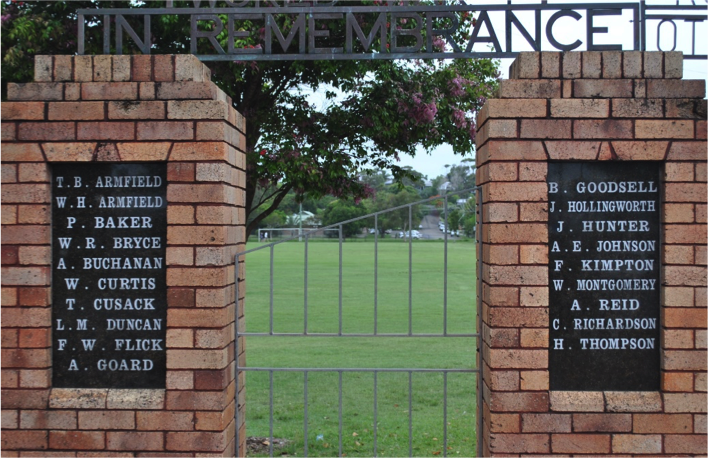
Local service men killed in World War I (Source – John Main)
For each there is an account of their military history in the Australian War Memorial Archives and National Australian Archives. Their stories are worth reading. Each has their name on the Roll of Honour Commemorative Area at the War Memorial.
See www.awm.gov.au and naa.gov.au/collection/explore/defence/service.
A summary of key information for each local soldier that died is shown in the Table below.
SERVICEMEN FROM THE BYRON BAY AREA WHO DIED IN WORLD WAR I.
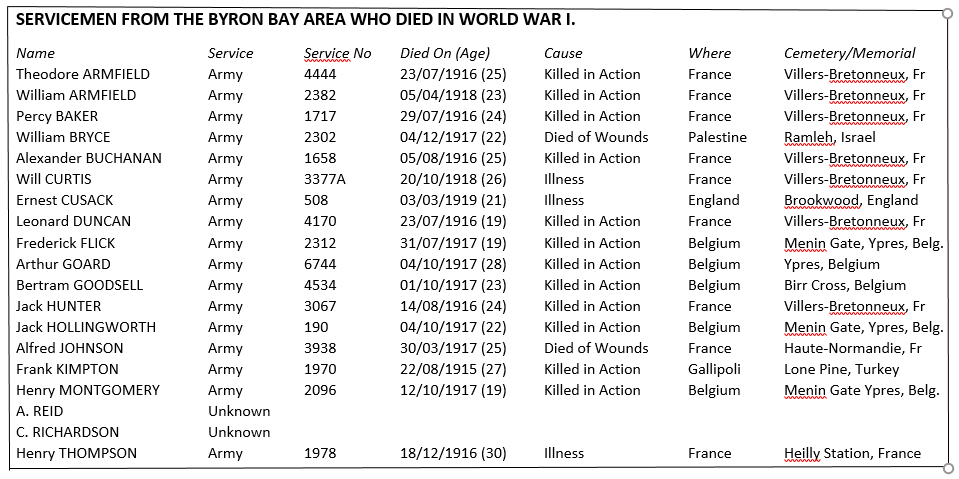
BYRON BAY LOCALS WHO SERVED IN WORLD WAR II.
Just as local men from the Byron Bay area answered the call to serve in World War I so they did in World War II. While many who answered followed similar callings such as labourers and farmhands as those who enlisted in the previous global conflict, there were representatives from the clerical cohort and professions. Some joined in early September 1939 within days of war being declared. Most joined in mid-1940 or in 1941 but there were enlistments right through to 1945. They served throughout the Pacific, African and European theatres in the army, air-force and navy. Some saw action in northern Australia and in Australian waters. A high proportion of Byron Bay’s servicemen joined the Air Force but fewer joined the navy.
In contrast with WWI most Australian WWII servicemen were trained in Australia. This meant a number of our military personnel also served in Australia training pilots, drivers, machinery operators, communication specialists, navigators and equipment repairers.
There are the names of 23 local men listed on the remembrance gates at the Byron Bay Memorial Park who answered the call to serve in WWII and who did not return home. Most died fighting in the major theatres of war, some died of wounds received in action, in prisoner of war camps or of illness contracted while posted. Others died in Australia training Australian servicemen or carrying out other duties assigned to them. There is naturally a heavy bias of casualties to the areas where Australia played a large role such as in North Africa, Singapore and Burma and in the high risk bombing raids in Europe. Locals in the merchant marine also lost their lives; some close to Byron Bay as in the sinking of the Wollongbar II by Japanese submarines.
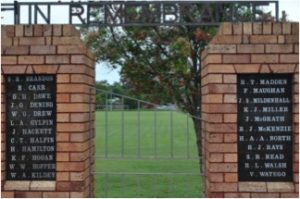
Local service men killed in World War II (Source – John Main)
Not all individual records are easily accessed but there are some details for each and for some a fuller account of their military service available. It is worth exploring these. See: www.awm.gov.au and naa.gov.au/collection/explore/defence/service
A summary of key information for each is shown in the Table below.
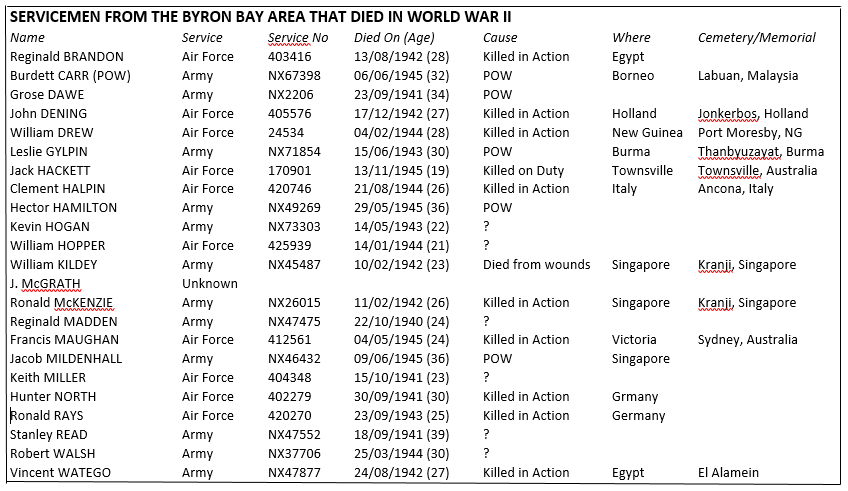
SHIPS ATTACKED, SUNK AND DAMAGED ALONG THE BYRON COAST DURING WWII.
There were 37 ships attacked by enemy action along the eastern coast of Australia during WWII as well as others that were sunk or damaged by other events. Eight of these attacks and events occurred in the waters along the 300 kilometre length of coastline stretching north from Byron Bay to south east Queensland and south to Coffs Harbour.
The closest enemy attack to Byron Bay was the torpedoing and sinking of the Limerick off Cape Byron by Japanese submarine 1-126 on 26 April 1943. Perhaps the most devastating was the night-time torpedoing and sinking of the Centaur hospital ship off the south east Queensland coast just 100 kilometres north of Byron Bay by Japanese submarine 1-178 on 14 April 1943. No warning was given and of the 332 on board only 64 survived. The wreck was finally discovered off South Stradbroke Island in December 2009.
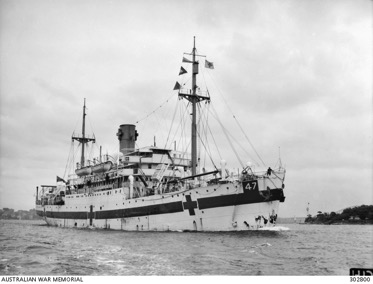
The Centaur Hospital Ship torpedoed and sunk by a Japanese submarine in April 1943.
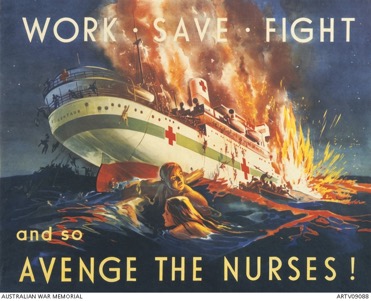
How Australians felt about the sinking of the Centaur with the loss of 268 lives.
Other ships torpedoed by Japanese submarines were:
- Kowarra off Sandy Cape by submarine 1-126 on 14 April 1943
- Caradale off Coffs harbour by submarine 1-180 on 12 May 1943
- Ormiston off Coffs Harbour by submarine 1-180 on 12 May 1943
- LST 469 off Coffs Harbour by submarine 1-174 on 16 June 1943
- Portmar off Coffs Harbour by submarine 1-174 on 16 June 1943
Perhaps the ship most closely related with Byron Bay that was sunk in WWII was the Wollongbar II the twin of the Wollongbar which was wrecked on the Belongil Beach on 14 May 1921. After loading a cargo of bacon and butter at Byron Bay and a later departure than planned on the evening of 28 April for Sydney the Wollongbar II was torpedoed and sunk off Crescent Head approximately 280 kilometres south of Byron Bay by Japanese submarine 1-180. Two torpedos hit the ship in quick succession at 10.15 am on 29 April 1943 breaking it in two. Both pieces sank within minutes giving those on board little chance of escape. Only five of the crew of 37 survived. The captain and a number of others that died were from Byron Bay. The delayed departure of the Wollongbar II from Byron Bay resulted from time it spent searching for survivors of the Limerick sunk off Byron Bay two days previously.
HUDSON BOMBER CRASHES AT BROKENHEAD IN WWII.
On 7 July, 1942 RAAF Lockheed Hudson twin engine bomber A16-198, returning from Horne Island in Torres Straight to Amberley Airforce base at Ipswich in Queensland became lost in low cloud and failed to arrive at the estimated time. At about 10pm that evening residents at Lennox Head reported seeing and hearing a low-flying aircraft flying north toward Byron Bay with landing lights on. The aircraft was never seen again and was assumed to have crashed. A search found part of an inflated life vest and a jacket with a crew member’s name on it but no sign of the aircraft nor any survivors or bodies. It was concluded the plane had crashed in to the sea and all ten crew had died.
In 1998 aircraft wreckage was raised in a trawler net from 57 metres of water three kilometres off Broken Head, just south of Byron Bay. It was confirmed as part of a Hudson bomber.
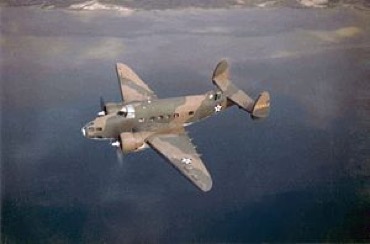
Lockheed Hudson Bomber of the type that crashed south of Byron Bay. (Source – Lockheed)
It is thought that after not finding Amberley the aircraft had proceeded well south of that base before the crew located its position. They then continued south heading for the next RAAF base at Evans Head, 50 kilometres south of Byron Bay. But before it reached the safety of that base the pilot realised that the plane would run out of fuel. In a last attempt to land and save the crew he turned the plane northwards near Lennox Head attracted by the light from the Cape Byron lighthouse presumably to make a landing on Tallow Beach guided by the lighthouse beam. Unfortunately the plane never made that landing and crashed into the sea just off the southern end of Tallow Beach.
A memorial plaque to the crew of A16-198 can be seen on Broken Head headland.